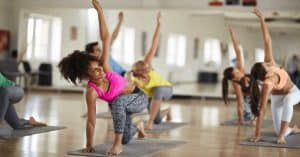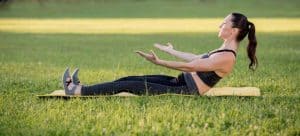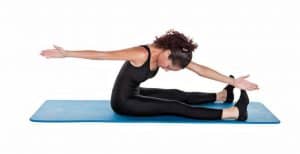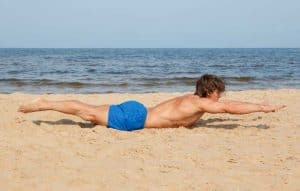
The development of a strong and healthy midsection, and the development of a strong and healthy mind can both be accomplished simultaneously through two different paths. Both Yoga and Pilates can increase core strength as well as developing fortitude of spirit. We focus on increasing the strength of the body through movement (the Asanas or poses), and simultaneously work on focusing the mind to work in better concert with the body, through the breath (pranayama). Both Yoga and Pilates focus on breath work as a means to connecting the mind and body. First, I’d like to focus on the Pilates Method, and how that can help to develop a strong body and mind.
Developing the Core
Let’s start by defining the physical core, and talk about how to get that in tip top shape!
According to Dictionary.com, the definition of the physical core is “The strength of the underlying muscles of the torso, which help determine posture.” So that would include not only the abdominal muscles, but also the rest of the muscles in the back, essentially from the neck through the hips. In Pilates, we focus entirely on core strength and stability through exercises designed specifically to balance the muscles, sides, back and front. The philosophy of Pilates includes Centering, Concentration, Control, Precision, Breath and Flow. Below, I’ve listed just a few that are great exercises to balance the core.
The Roll Up:
Roll Up is a great challenge for the abdominal muscles, and a great way to start work on full range of motion, and articulating the spine. It has been said that one well executed Roll Up is equal to six regular sit ups, and is much better than crunches for creating a flat stomach. Part of the reason is the breath control. You inhale deeply at the bottom, you exhale as you lift, vertebra by vertebra, scooping in your middle as you reach for your feet. The process of exhaling tucks the abdominal muscles in further, lifting the diaphragm, and strengthening while lengthening.

The Saw:
Perhaps an unusual choice, but the Saw is a great exercise for a couple of reasons. It reinforces good posture—you sit with your legs in front, in a “V,” lifting the chest high and shoulders back. The arms are straight out to the sides. You reach across your body, saw three times outside the foot or lower leg, sit up tall, and reach to the opposite side. Percussive breath is acceptable, or breathe deeply as you sit up, exhale as you reach forward (again, emphasizing the natural inward pattern of the breath and the abdominal wall, with the exercise).

The Swimmer:
I like to strengthen the back with the Swimmer. My personal preference is to start out slow, lifting the opposite arm and leg, and then do a few small sets faster. This prone Pilates exercise strengthens the back, and again, reinforces good posture and alignment. On the slower set, I have the class breathe in on one side, and out on the other. On the faster sets, I have them breathe in for 5 flutters, and out for 5. Be sure to lift your belly button away from the floor, tightening the core. It’s easy to cheat on this one, by letting the core rest.

Joseph Pilates’ philosophy was to aid the body in healing itself. He believed that that the modern lifestyle, bad posture, and inefficient breathing were the roots of poor health. His answer was to create his series of exercises to improve muscular imbalances, posture, and overall health. His true legacy remains his original 34 Contrology Exercises.
A Strong Core Both in Body & Mind
This portion will focus on developing a strong core, both mind and body, through Yoga practice. We focus on increasing the strength of the body through the poses (Asanas), but Yoga is an integrated practice. It has a strong component of strengthening the mind and spirit as well, not so much in a religious sense, but in the sense of trying to obtain inner peace.
These days, we are all seeking some sort of purpose and meaning. Yoga practice can help you to focus your attention on calming your mind and taking care of your body through the 8 Limbs (Ashtanga), originally submitted by Patanjali. The 8 limbs are a way to achieve true inner peace and enlightenment.
The first limb, Yamas, deal with one’s ethical standards, focusing on our behavior, and how we conduct ourselves in life. They are universal practices that are best equated to what we know as “The Golden Rule”, “Do unto others as you would have others do unto you.”
Niyama, the second limb, has to do with self-discipline and spiritual observances. Regularly attending temple or church services, saying grace before meals, developing your own personal meditation practices, or making a habit of taking contemplative walks alone are all examples of niyamas in practice.
The third limb is the most commonly known and practiced—the Asanas, or poses. Most people come into a Yoga class expecting to do poses, to work out and stretch, and it highly depends on the type of class as to the vigorousness of the poses. Some classes are “Vinyasa Flow” classes, in which each movement is linked to the next, and so you are “flowing”. Others focus on each pose, holding for a number of breaths. Still others may include chanting or meditation. There may even be a combination of all of the above. The poses tire your physical body, in preparation for the upcoming limbs.
Pranayama is the breathing and breathing exercises utilized in Yogic practice. The breath is a way to connect with the body, to make the union between mind and body (Yoga literally means “union”). The breath is the link, and there are many breathing techniques that can be beneficial, even on their own, for calming and soothing the nervous system, and even for people with asthma and other lung related issues.
Pratyahara, the fifth limb, is a withdrawing of sensory applications, and a drawing of the attention inward. It’s being aware of the outside world and stimuli, but being able to be separate from that. This detachment aids in meditation, and also in objectively observing what we might want to change about ourselves.
Dharana is the result of the preparation of Pratyahara–it’s the concentration we develop once we can detach and be objective. Now the focus becomes trying to quiet the mind–no easy task! We all have thousands of things going around in our minds at once. Even in Savasana (the relaxation pose at the end of class), I see people twitching and itching and jumping in their skin. It’s hard to quiet the mind. One specific application here, though, is that when you can quiet the mind, you can sleep at night.
The seventh limb, Dyana, is meditation or concentration. Dhyana is ultimately a state of being keenly aware without focus. At this stage, the mind has been quieted, and in the stillness it produces few or no thoughts at all. The strength and stamina it takes to reach this state of stillness is quite impressive. Don’t give up! If you’ve gotten this far, you are doing very well, indeed. Yoga is a practice, it’s not supposed to be perfect. We are all at different points, and the effort is what counts.
Samadhi, the final limb, is a state of connectedness with the universe and all living things. The person practicing has been able to transcend the self, and has created an awareness of everything, and nothing, at the same time. This can be compared to doing something you love, and reaching the “zone”; that place where your body does the activity without conscious thought and it becomes sheer joy. Whether that’s a sport, or an art, like painting, we’ve all experienced moments like this. This is just the process by which to get there more easily.
The core of your body is worked through the poses, and the core of your spirit, is worked through the 8 Limbs. It’s an interesting and very old process, worthy of deep respect. The next time you hit a yoga class, remember how much more is involved than just the poses!
Check out Elite’s full schedule of mind/body Pilates and Yoga classes on our online calendar.

Written by Melissa Abramovich, ACE CPT, NASM CGT, AAHFRP Medical Exercise Specialist at Elite Sports Club-River Glen
Melissa Abramovich went into Personal Training and Group Exercise instruction after successfully losing 140 pounds through healthy diet and exercise. Her desire to help others drove her forward into a career helping others to make healthier choices. She is an ACE certified personal trainer and now also a Medical Exercise Specialist (AAHFRP), helping clients with a myriad of health issues at Elite Sports Clubs. She holds a Bachelor’s degree, and many group exercise related certifications as well.
1 Comment
Good one Melissa!